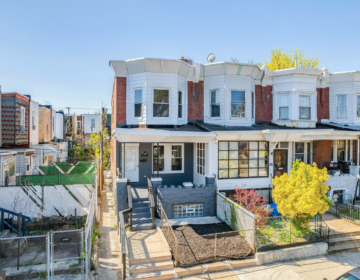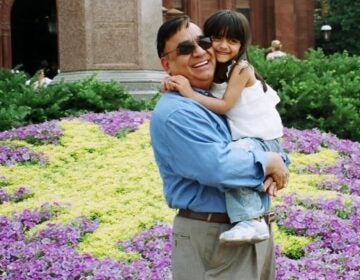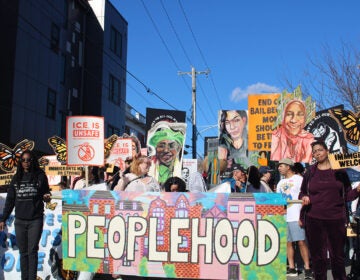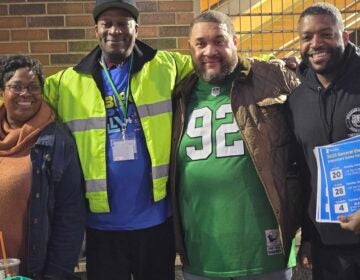Archaeologists are digging to the bottom of Philadelphia’s Black Bottom
An urban archaeological excavation is searching for artifacts from the West Philly neighborhood destroyed 50 years ago.
Listen 1:19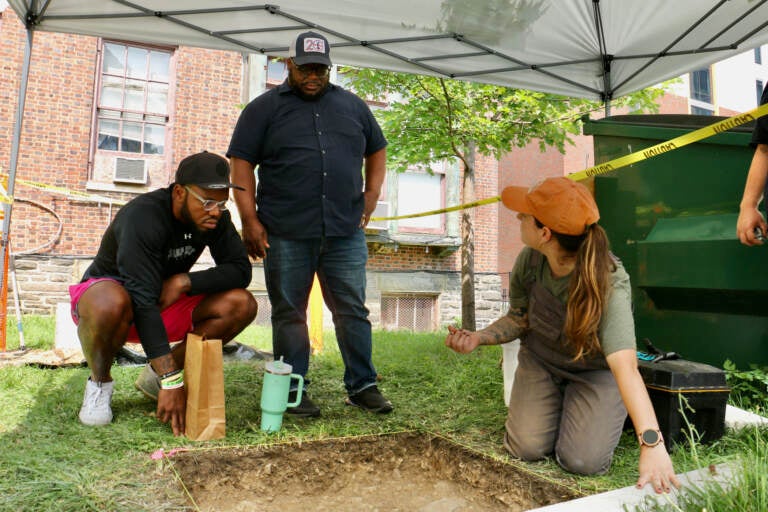
Penn anthropology student Autumn Melby shares the day's finds with community activists Chris Burney (left) and James Wright. (Emma Lee/WHYY)
There is a perfect hole, exactly one square meter, dug on the edge of a gravel parking lot behind the Community Education Center building on Lancaster Avenue in Powelton Village.
Archaeologists hope that hole will be a portal to the Black Bottom, the neighborhood that used to be here before it was bulldozed in the 1960s.
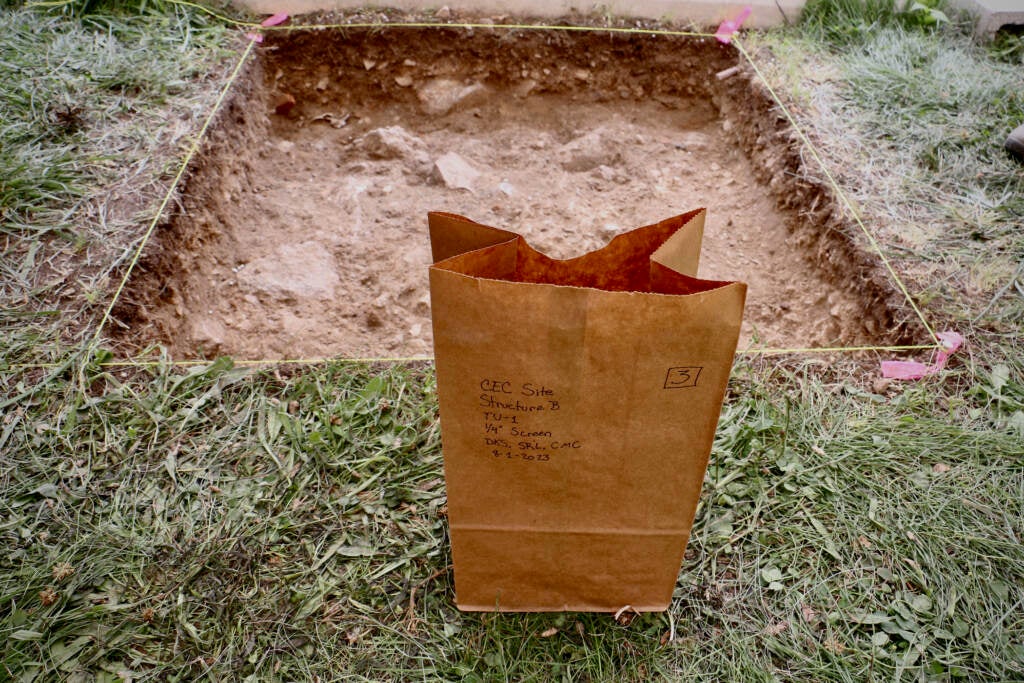
Tuesday, the first day of a two-week dig, did not reveal much: Archaeologist Doug Smit sorted through a brown paper bag with things like a shard of brown glass that might have been a medicine bottle, a wire nail likely from mid-century, and a dress pin.
“Like this thing,” said Smit, holding up a squat cylindrical-shaped object that might be made of enamel but he wasn’t sure. “We don’t know what it is. So, you know, we’ll find out.”
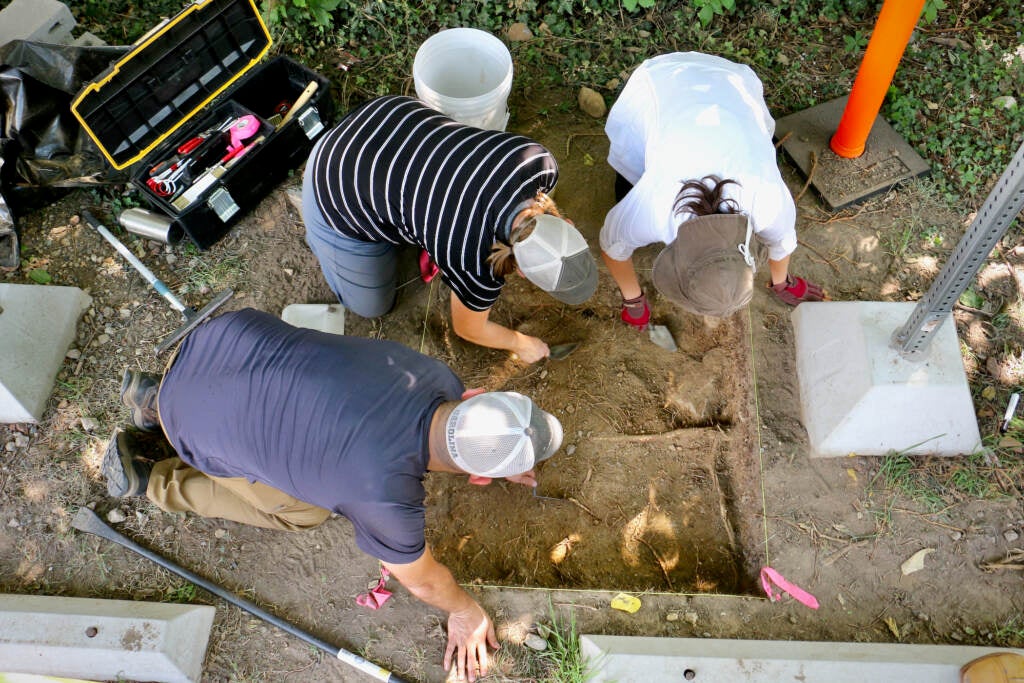
Smit, a teaching assistant professor from the University of North Carolina at Chapel Hill, is part of Heritage West, a community archaeological project to discover the recent past of this West Philly neighborhood.
He and his colleagues Megan Kassabaum and Sarah Linn, both archaeologists at the Penn Museum (associate curator and assistant director of academic engagement, respectively), are carefully digging a hole in the shadow of the towers of Drexel University and Penn, campuses that benefited from the destruction of the Black Bottom in the 1960s.
They chose this spot based on ground penetrating radar tests, which show a likelihood of a wall or foundation underground. These preliminary digs, limited to one square meter, are studies in preparation for a more significant excavation project to begin in September.
“We know from historic maps that there were a series of homes that once stood in this parking lot, three brick rowhouses along one side and two sets of wooden twins,” said Kassabaum, associate professor of anthropology at the University of Pennsylvania.

“We’re hoping to find the remains of those structures,” she said. “But more importantly, the remains that will tell us about the lives of the people who lived in those structures from the time they were built until the time they were abandoned.”
From maps and census records, they can identify who lived in the house that used to be here. Smit said it was likely Stonewall and Mary Jones, who migrated north to Philadelphia from King George County, Virginia, shortly before 1910. He was a driver, she likely was a maid. They had five kids.
But that’s where the historic record stops.
“What was their food like? What was their daily life like? What kinds of toys did the kids play with? How much of their life did they bring from the South?” Smit said. “Those are the kinds of questions that we can answer with archaeology.”
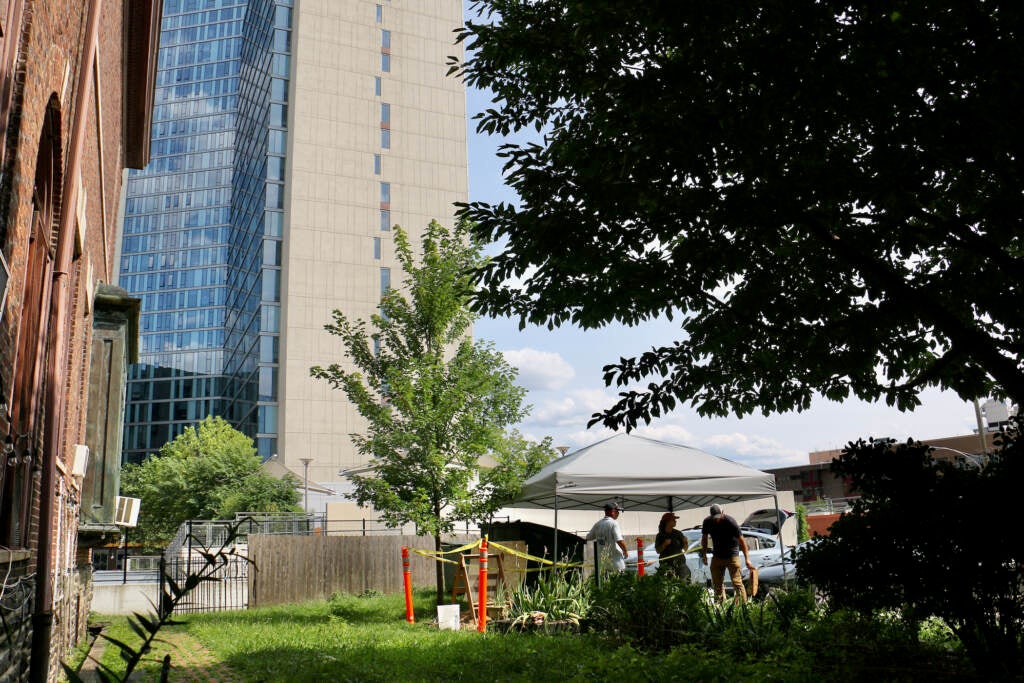
The Black Bottom was a neighborhood that developed around the year 1854, stretching from Walnut Street to Lancaster Avenue, from 32nd to 40th streets. It later became a landing place for the mostly Black population who migrated from Southern states to the North in the 1910s and 1920s.
Dr. Walter Palmer, 89, a lecturer at the University of Pennsylvania, grew up in the neighborhood and witnessed its eradication, in large part by Penn.
“Penn came into the area about 1872, 1873, and was an aggressive developer,” said Palmer, who has been trying to preserve the legacy of the neighborhood as a member of the Black Bottom Tribe. “They built 30 or 40 buildings before the turn of the century, shutting down a lot of streets which were used by members of the Black Bottom to go to hospitals, go to school.”
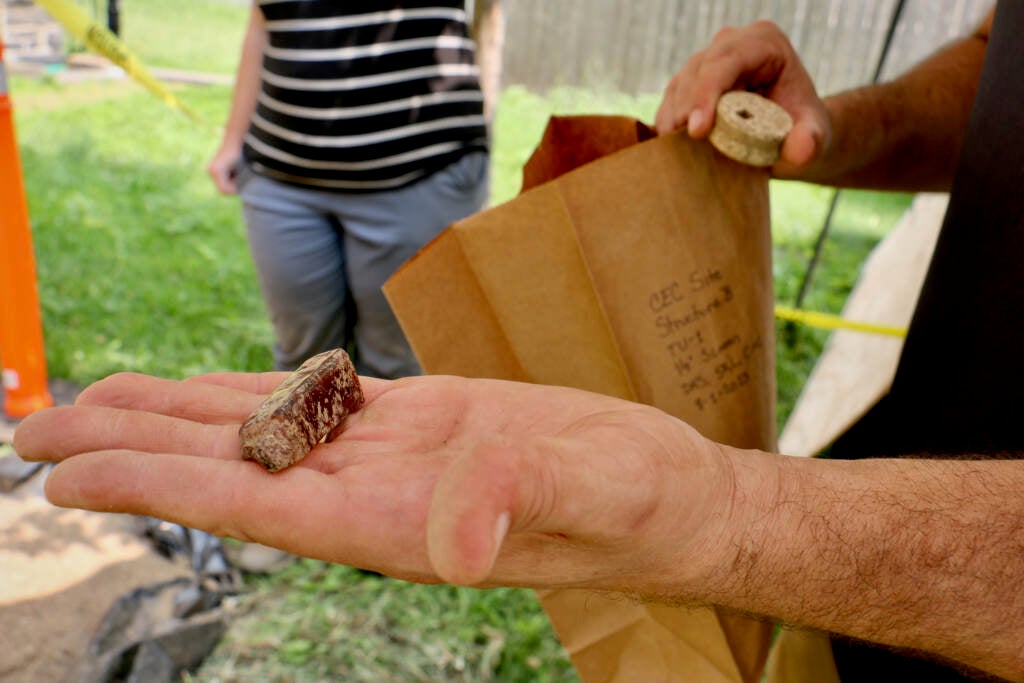
A largely low-income neighborhood, in the 1960s the Black Bottom was ultimately targeted for what was dubbed “urban renewal.” With the use of federal funds, the entire neighborhood was acquired by sale or eminent domain and razed in the 1960s. Surrounding institutions — including Penn and Drexel — moved in.
“Displacing anywhere from 3,000 to 5,000 people,” said Palmer. “And about 5,000 to 8,000 homes and properties.”
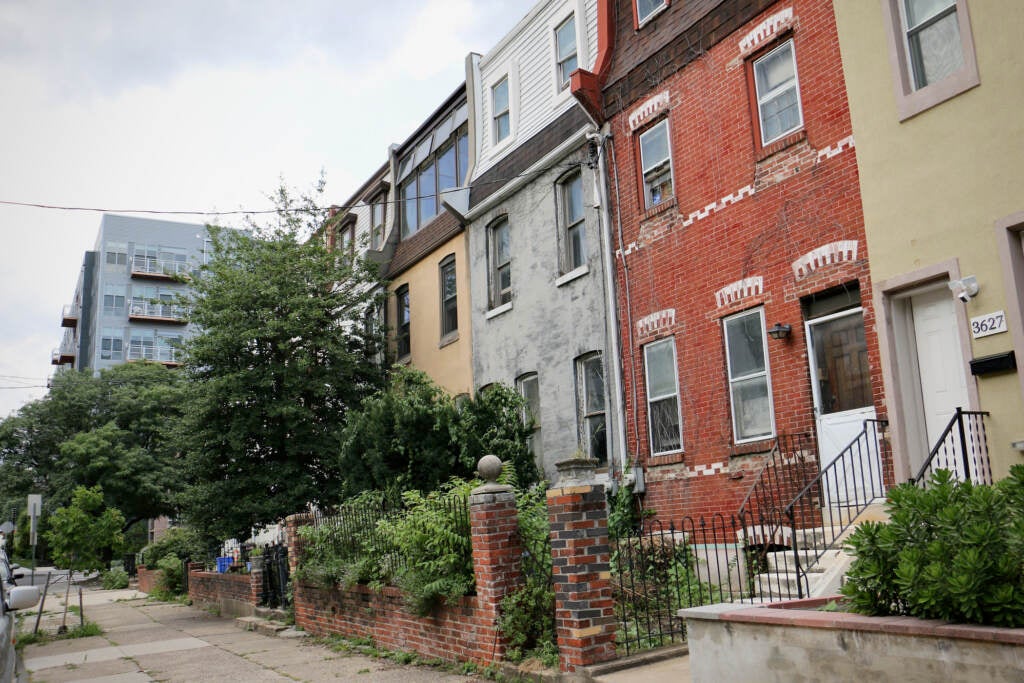
Smit, the archaeologist, said the first layer of earth will show the violent way in which the building stock was torn down: quickly, with bulldozers, compressing objects from various time periods into the same layer.
They have to penetrate that layer of archaeological “noise” to get to the real story of the neighborhood — “to get to the beginnings of the Black Bottom, rather than the end,” said Smit.
Aside from a single string of rowhouses on Warren Street at 36th, nothing remains of the Black Bottom. Even a tile mosaic map of the neighborhood, made as a memorial on the campus of University City High School, was destroyed in 2015 when the school was torn down.

Nevertheless, people in the neighborhoods around Penn and Drexel still associate with the Black Bottom. James Wright of HopePHL — a community support organization recently formed from the merger of the People’s Emergency Center and Youth Service, Inc — said the memory of the neighborhood is ingrained in the culture of West Philadelphia, even for people with no direct tie to the Black Bottom.

“What was a specific neighborhood has become the entire neighborhood north of Market Street. Everyone has adopted the name The Bottom,” Wright said. “It really has informed the way community groups engage with different power bases. It has informed their process of engagement for a long time.”
HopePHL along with the CEC, on whose property the dig is happening, are partners in the West Heritage archaeological project. They are helping engage community members to participate in the dig.
Kassabaum said community engagement is a crucial part of Heritage West, particularly because the project is largely funded by Penn, the institution that once benefited from the destruction of the Black Bottom.
“We can’t go back and fix that history, and we certainly can’t change anything major about our institutions,” she said. “But I think we can say: Here’s the piece that we know how to do. We know how to excavate the lives of people, and talk about those people, and read people the past in an important way.”
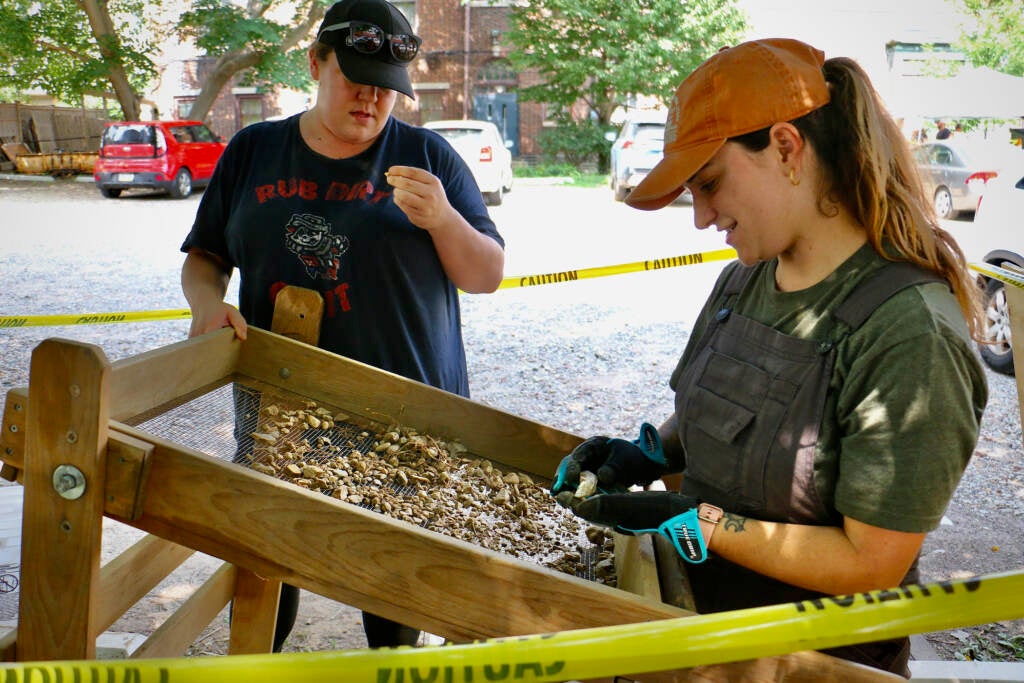
This kind of archaeology is not ancient: Unlike Egyptian pyramids or Grecian temples, there are people with direct ties to the Black Bottom alive today, or one generation removed. The director of the partnering Community Education Center, Theresa Shockley, hopes the dig will trigger descendants of the Black Bottom to come forward with their own objects from the old neighborhood.

“I bet there are things around. Maybe not in that hole,” she said, pointing to the square dug out of her parking lot. “If people recognize this project, maybe it would give them the impetus to bring those things forward and say, ‘Can you identify this? We’ve had this in our family for so many generations.’”
“I think that’s an exciting thing that could come out of this,” she said. “People are excited.”
The archaeologists of the Heritage West will be digging until mid-August, then returning in September for a months-long dig. The public is invited to join on Fridays, with a few weekend events to be scheduled on select Saturdays.

Get daily updates from WHYY News!
WHYY is your source for fact-based, in-depth journalism and information. As a nonprofit organization, we rely on financial support from readers like you. Please give today.




